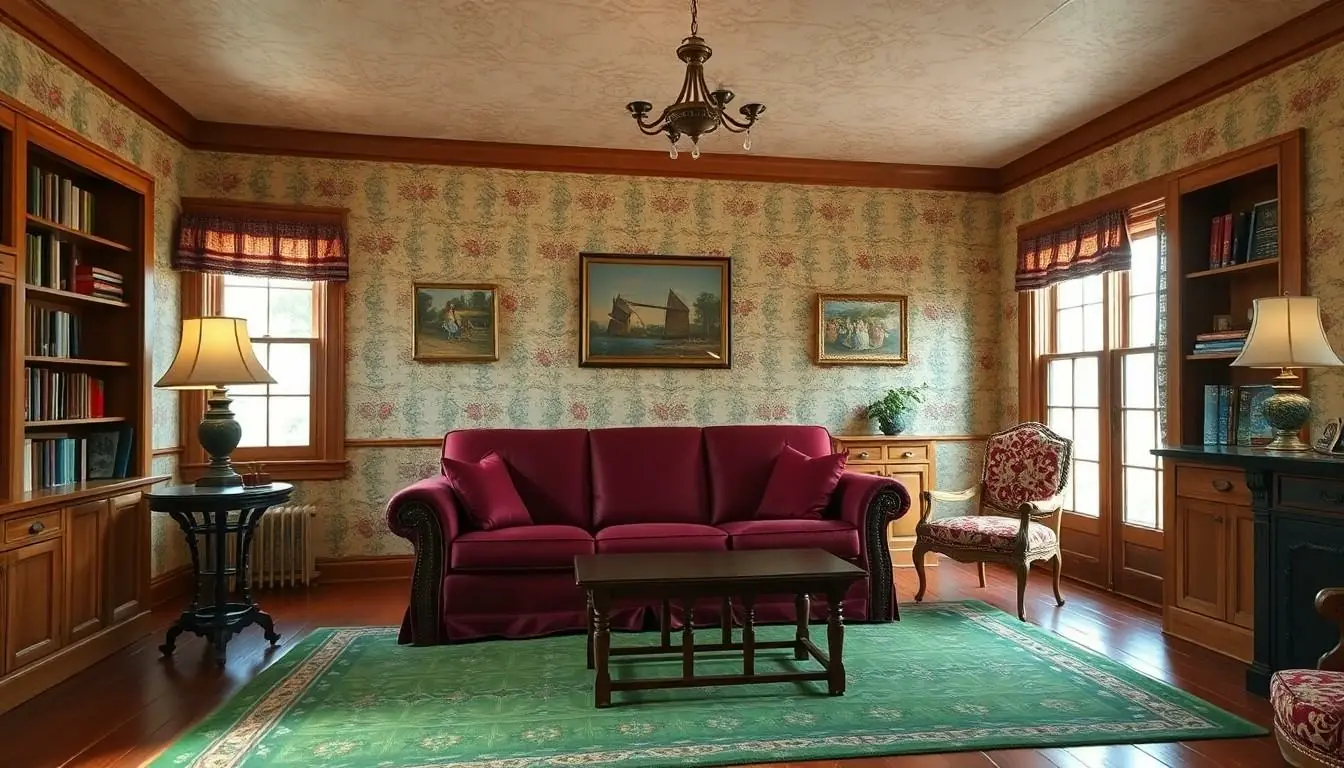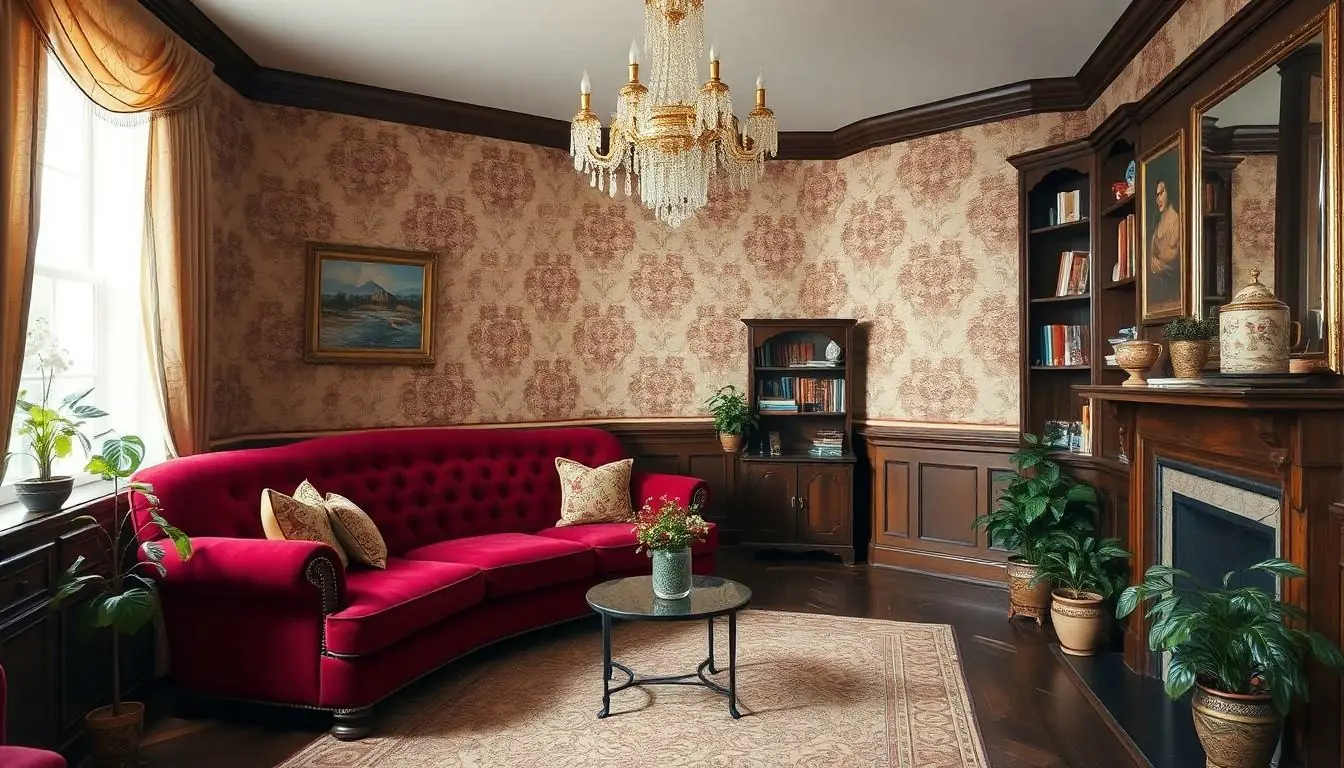Step back in time to the fabulous 1910s, where home interiors were a delightful mix of elegance and quirkiness. Picture plush velvet sofas, ornate wallpaper, and the kind of knick-knacks that would make your grandmother swoon with nostalgia. This was an era when homes weren’t just places to live; they were stages for showcasing the latest trends and family heirlooms, all while trying to avoid the wrath of the local gossip.
In this article, we’ll explore the enchanting world of 1910 home interiors, where every detail told a story. From the bold colors that danced across the walls to the intricate patterns that adorned the floors, the charm of this decade is irresistible. So grab a cup of tea, settle in, and let’s dive into a time when homes were as stylish as they were cozy, and maybe even discover how to bring a touch of that vintage flair into modern living.
Table of Contents
ToggleOverview of 1910 Home Interiors
1910 home interiors reflect a rich tapestry of design elements that embody both luxury and individuality. Vibrant colors and intricate patterns characterized the decade, showcasing a mix of Victorian and Arts and Crafts styles. Velvet sofas adorned with tassels offered both comfort and elegance, becoming focal points in living rooms. Ornate wallpaper featuring floral motifs or geometric designs added depth to spaces, creating visually stimulating environments.
Woodwork played a significant role in these homes. Dark-stained oak and mahogany were commonly used for trim, moldings, and furniture, reinforcing a connection to traditional craftsmanship. Additionally, built-in bookcases and window seats showcased family heirlooms and beloved volumes, emphasizing the importance of heritage.
Lighting fixtures displayed artistic flair, with chandeliers made from crystal or brass illuminating dining areas and parlors. Art glass lamps provided warm light, often adorned with colorful patterns. Beyond illumination, these fixtures became integral decor elements.
Furnishings included eclectic pieces representing a blend of styles. Mission furniture showcased simple lines and functionality, while more decorative items brought charm and character. Tapestries and embroidered cushions added textures, enhancing the environment’s warmth.
The décor also embraced natural elements. Houseplants became popular, with ferns and palms bringing a touch of the outdoors inside. In this era, homes transformed into personal sanctuaries, combining elements of comfort with fashionable aesthetics. Each interior told a story, reflecting the personalities and values of its inhabitants.
Key Design Features

Home interiors in the 1910s showcase a distinctive style that blends elegance with unique characteristics. Various design elements defined these spaces, from architectural styles to color palettes.
Architectural Styles
Victorian and Arts and Crafts styles significantly influenced 1910 home interiors. Ornate details characterized Victorian designs, featuring intricate moldings and elaborate trim throughout spaces. Arts and Crafts emphasized simplicity and handcrafted elements, integrating natural materials into architecture. Craftsman bungalows gained popularity, highlighting low-pitched roofs and broad front porches. Built-in furniture complemented these styles, with bookcases and window seats serving functional and aesthetic purposes. Overall, architectural features captured the essence of comfort, style, and individuality, creating welcoming environments for families.
Color Palettes
Bold colors and rich textures defined the color palettes of the 1910s. Deep greens, burgundies, and navy blues dominated living spaces, adding warmth and sophistication. Accent colors included mustard yellows and rust reds, enhancing the overall vibrancy. Decorative wallpapers often featured intricate patterns and floral motifs, creating visual interest on walls. Additionally, furniture upholstery showcased luxurious fabrics like velvet and brocade, reinforcing the era’s opulence. These color choices combined to create inviting atmospheres, reflecting the personalities and preferences of homeowners at the time.
Popular Materials and Textiles
The 1910s interior designs showcased a variety of materials and textiles, reflecting the era’s unique aesthetic vision. Homeowners often emphasized comfort and elegance through their choices.
Wood and Wallpaper
Dark-stained oak and mahogany dominated the woodwork, establishing a foundation of traditional craftsmanship. Built-in features, such as shelves and window seats, highlighted these woods while serving practical purposes. Ornate wallpapers adorned walls, featuring floral and geometric patterns in vibrant colors. Designers often chose rich hues, like deep greens and burgundies, to create inviting atmospheres. Combining wallpapers with wooden accents established a warm, cohesive look that defined many interiors of that time.
Fabrics and Upholstery
A mix of textiles enriched the living spaces, with plush velvet and intricate brocade being particularly popular. Sofas and chairs often boasted these luxurious fabrics, providing comfort alongside visual appeal. Bold upholstery colors complemented the era’s wallpaper, tying rooms together effectively. Cotton and linen also played essential roles, often used in lighter draperies and decorative pillows. Decorative tassels and fringes added additional flair, enhancing the overall aesthetic. The focus on fabric quality and variety underscored the personality and individuality of each home.
Furniture Trends
Furniture trends in the 1910s showcased a combination of elegance and functionality, reflecting the tastes of the era. This time marked a shift towards comfort, with bold patterns and rich fabrics playing a significant role in interior design.
Common Furniture Pieces
Commonly found furniture pieces included overstuffed sofas, sturdy wooden tables, and mission-style chairs. Homeowners favored plush velvet upholstery in deep hues, providing comfort and style. Built-in bookcases featured prominently, inviting displays of family heirlooms and literature. Additionally, dining sets often consisted of dark, stained oak, highlighting traditional craftsmanship. Coffee tables with intricate designs showcased decorative elements, while art glass lamps added both beauty and practicality to spaces.
Notable Designers of the Era
Notable designers influenced the aesthetics of home interiors during the 1910s. Gustav Stickley, known for his contributions to the Arts and Crafts movement, emphasized simplicity and quality in his designs. His furniture focused on handcrafted techniques, appealing to consumers seeking authenticity. Charles Rennie Mackintosh gained recognition for his unique approach, blending geometric forms with floral motifs. Edward Wormley also emerged as a significant figure, blending modernism with classic design characteristics, which appealed to a broad audience. Each designer contributed distinct elements, enriching the tapestry of 1910 home interiors.
Decorative Elements
Decorative elements from the 1910s showcase a rich blend of style and artistry. This era emphasized not just beauty but also the practicality of design.
Lighting Fixtures
Lighting fixtures served as statement pieces in 1910 home interiors. Crystal chandeliers illuminated dining rooms, reflecting elegance in every detail. Art glass lamps brought a colorful warmth to living spaces, enhancing both functionality and aesthetic appeal. Oil lamps, though less common, contributed a cozy charm, particularly in more rustic homes. Each fixture played a crucial role in creating inviting atmospheres, blending seamlessly with ornate woodwork and textiles.
Artwork and Accessories
Artwork and accessories added personality to 1910 interiors. Framed paintings, often featuring pastoral scenes or floral still lifes, adorned walls and provided focal points. Decorative ceramics and vases showcased craftsmanship, while eclectic collections of family heirlooms personalized spaces. The use of area rugs defined seating areas, adding warmth underfoot. Accessories like intricate picture frames and ornate mirrors reflected the character and values of homeowners, completing the overall design narrative.
The allure of 1910 home interiors lies in their ability to blend elegance with personal expression. This era’s distinctive design elements continue to inspire contemporary decor, inviting homeowners to embrace vintage charm. The rich colors patterns and craftsmanship of the time create a warm atmosphere that resonates with today’s aesthetic values.
By incorporating features like plush upholstery built-in bookcases and artistic lighting, anyone can evoke the spirit of the 1910s in their own space. The legacy of this decade serves as a reminder of the beauty found in both tradition and individuality. Exploring these timeless design elements allows for a deeper appreciation of history while enhancing modern living environments.



